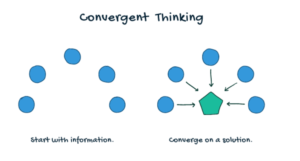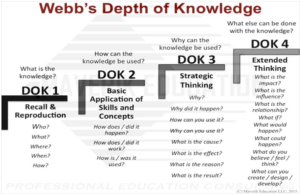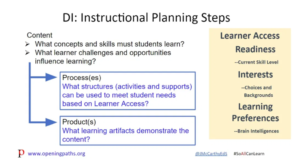When I began my journey in teaching. The very first question I had was, how do I teach? Is there some magical spell or potion that allows me to teach perfectly?
The answer is no. It’s all trial and error. No one knows the art of perfect teaching. We all learn from our mistakes. Even the best strategies were developed over time by understanding the needs of our students and the ever-changing demands of the world.
We must remember, the strategies that we use within the classroom isn’t just to teach efficiently or to make them learn faster. It is to make sure that they take home something more than just the lessons that they are learning within the classroom. It’s to prepare them for what lies outside the classroom.
There are innumerable research-based strategies, but I am not going to go through them all. I’ll talk about the ones that I end up returning to, which have been my go – to strategies since the beginning. The best part is they are all in a way connected to one another. So, in applying one of them, we can seamlessly weave in the other, because there is more than one way to teach a diverse and dynamic classroom.
-
Active Learning
Let’s start with the basics. No child likes to hear a teacher go on for hours about a topic. Active Learning puts the students before the teacher. This strategy is known for keeping the students engaged along with the teachers because we are constantly working to help the students reach their potential. The students learn better and smarter.
Some active learning strategies include:
- Reciprocal questioning: Have students come up with questions for the class on a recent lesson or concept.
- The pause procedure:Take a break every 10 to 15 minutes so that students have time to discuss, ask questions or solve problems.
- Muddiest point:Ask students to write down which point in the lesson is the least clear to them.
- The devil’s advocate approach: Ask one or more students to take the opposing side of a predominant argument or point of view being discussed during a lesson.
This strategy allows the students, to think more critically, be more engaged and develop a deeper understanding with the concepts that they are learning.
-
Convergent and divergent thinking
This is one of my personal favourites, mostly because we get to see all the different ways the students view a problem and try to come up with a solution. You can see the way their eyes light up when they realize that they have got it.
The main basis of this strategy relies on the factor of problem solving. As a math teacher it has been a great help in building math fluency.
American psychologist JP Guilford coined the terms in the 1950s, which take their names from the problem-solving processes they describe.
Convergent thinking involves starting with pieces of information, converging around a solution.

It emphasizes finding the single, optimal solution to a given problem and usually demands thinking at the first or second Depth of Knowledge (DoK) level. The application of this strategy works hand in hand with DoK.
Determining the correct answer to a multiple-choice question is an example.
Divergent thinking, on the other hand, starts with a prompt that encourages students to think critically, diverging towards distinct answers.

The prompts — in the form of guiding questions — are open-ended and typically require thinking at the third, or even fourth, Depth of Knowledge level.
Writing an essay and brainstorming are examples of exercises that demand divergent thinking.
This teaching strategy relies on the creativity of both student and teacher, where in, we as teachers come up with interesting questions or prompts, the solution to which is generated by the students.
-
Webb’s Depth of Knowledge
DoK has always been kind of a challenge to me. I keep going back to it in a stubborn kind of way. This is mostly because applying all aspects of it does take time. Theoretically it makes sense, but application is different especially when we think of consistency.
There are four levels to it:
- Level one: Recollection and reproduction
- Level two: Knowledge application
- Level three: Strategic thinking
- Level four: Extended critical thinking
A first-level challenge may only require reciting a math fact. A final-level scenario may involve solving a real-world issue using content from different subjects.
But keep in mind, it varies between subjects and age groups. As a teacher we can deliver different levels to students based on various assignments and activities.
When it comes to DoK, planning is key. Designing and breaking down the concept for four levels as well as keeping in mind the need to differentiate is a necessity. I have found the concept of mix and match to be helpful.
This is where I take the strategies which work, mix them, and match them to the needs of my students.

-
Gamification
When I heard the term gamification during my first-year teaching, I more less pictured children running around with their PSPs. Needless to say, I was wrong. This is a student focused teaching strategy. More so than most because it genuinely involves the application of elements that interest the students. It isn’t just about playing games, rather it involves implementing the elements of gaming within the classroom.
It is an effective way to take a child’s love for play and turn it into a love of learning. The benefits are huge: gamification can help students focus and build essential skills. It keeps them engaged and motivated.
When I began to think about how to gamify my classroom, I was a bit confused. But there are simple ways we can do so:
- On tests and assignments, you can give scores both traditionally and in the form of experience points (XP). You can also award XP for completing extra-curricular assignments, participating in class or anything else that demonstrates an effort to learn. For example, if a student scores 75% on a quiz, give them 7,500 XP.
- Make progress visible.
- As the students’ progress in something, call them stages, where they receive certain amount of XP to progress to the next stage.
- Give rewards.
- Peer feedback. Instant feedback provided by friends allows for increased social interaction and promotes constructive criticism.
- Structure problems effectively: Gamification works best when surrounded by clear rules and expectations.
If you still need an idea!
-
Differentiated instruction
I cannot stress enough the necessity of this strategy within the classroom. When we teach it is easy to feel as though every child has grasped the concept once the bell rings. In some cases, yes, the concept is simple, the students would have learnt it. But at times a child might not have understood.
Every child is different. The way they learn is different. So too must our way of teaching vary depending upon the needs of the student.
Differentiated interaction caters to the need of every student. It is effective teaching strategy that involves reacting to the diverse learning styles in every classroom with adjusted content and processes.
Strategies like learning stations and the think-pair-share method are small ways that you can bring unique learning experiences to your students.

Final thoughts on techniques:
Every teacher thinks differently. Every class is different. We strategize based on our needs within the classroom. These are some of the ways I strategize.
There are so many techniques that at times it’s absolutely overwhelming. I remember having 10 different tabs open and staring at the screen in a dazed manner, thinking what do I do?
But that’s the best part about teaching. We get to choose. We get to choose based on what works for us. We get to experiment.
So, start small and mix it up and see what works for you within the classroom.
Children are unique and the ways to teach them must be unique too.







